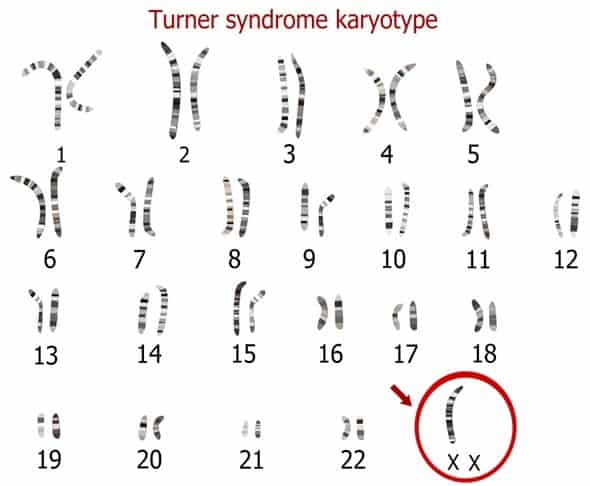Turner syndrome karyotype is 45XO. It means someone with Turner syndrome has a total of 45 chromosomes instead of 46. The missing chromosome is a sex chromosome that could either be an X chromosome or a Y chromosome. Since in Turner syndrome, one has a solitary X chromosome the person is always a female.
Turner symptom affects 1 in 2000 live births. It only affects girls. Turner syndrome chromosome variation happens in the womb and it is not related to maternal age.

Characteristics
Turner syndrome can produce a wide range of signs and symptoms. Here are some of the common features of Turner syndrome:
Before birth
- Cystic hygroma – An abnormal swelling that usually appears on a baby’s neck or head. There may be one or many cysts that tends to grow larger over time.
- Congenital heart disease
- Bicuspid aortic valve
- Coarctation of aorta
- Ventricular or atrial septal defects
- Anomalous pulmonary vasculature connections
- Brachiocephalic artery dilatation
- Kidney abnormalities
Duplex Collecting Systems – Condition in which a kidney has two ureters. Causes a back-flow of urine that can result in frequent UTIs and potential damage the kidneys.
Horseshoe Kidney – Most common renal abnormality found in patients with TS. Occurs during development of the fetus when the kidneys fuse together and create a horseshoe shape. Although the condition can potentially have no symptoms, the most common problems faced by a child with renal fusion include UTIs, kidney stones, and Hydronephrosis (kidney swelling).
Crossed ectopia – condition in which one of the kidneys crosses to the opposite end of the abdomen, and both kidneys lie on the same flank, where they can potentially be fused together. Although this condition usually has a lack of symptoms, it can result in UTIs or urinary obstructions. Patients with crossed ectopia can also experience flank pain, hematuria, or dysuria.
At birth and during childhood
- Webbed neck
- Low-set ears
- Widely spaced nipple
- High-arched palate
- Cubital valgus
- Lymphoedema – swelling of limbs
- Delayed growth
- Short fingers
- Small jaw
In adolescence and adulthood
- Slowed growth
- Lack of secondary sexual characteristics e.g. appearance of pubic hair.
- No growth spurt during pubertal age
- Early menopause
- Inability of conceiving
Causes of Turner syndrome
Monosomy – This usually due to problem in mother’s ovum or father’s sperm. All the cells of the body gets one X chromosome.
Mosaicism – Here some cells of body gets two X chromosomes and some cells of the body gets only one X chromosome. This happens due to an error of cell division in early fetal life.
X chromosome abnormalities – Here one X chromosome is normal and another X chromosome is altered or partial. This pattern can be seen in all cells of body or this can also show a mosaic pattern where some cells have two normal X chromosomes and some cells has one normal X chromosome and another abnormal X chromosome.
Y chromosome material – This is case, there is two X chromosomes but in one X chromosome there is Y chromosome material. Ultimately the persons are female but due to presence of Y chromosome material they have increased risk of gonadoblastoma.
Diagnosis
- Certain features on an ultrasound image during fetal development may raise suspicion that your baby has Turner syndrome or another genetic condition affecting development in the womb.
- Prenatal screening tests that evaluate the baby’s DNA in the mother’s blood (cell-free fetal DNA testing or noninvasive prenatal screening) may also indicate an increased risk of Turner syndrome.
- Your pregnancy and childbirth specialist (obstetrician) may ask if you’re interested in additional tests to make a diagnosis before your baby’s birth. One of two procedures can be performed to test for Turner syndrome:
- Chorionic villus sampling – This involves the removal of a small piece of tissue from the placenta. In this test, a sample of the amniotic fluid is taken from the uterus.
Treatment
Turner syndrome is not curable at present. But symptomatic treatments can be done and complications can be minimized. For example, growth hormone can increase the final adult height. Hormone therapy can help to develop breasts and menstrual cycles. Surgery can fix heart defects. High blood pressure, diabetes, and thyroid problems can be treated by various medications. Only a small number of women with TS are able to have children on their own, and pregnancy has risks in TS. But several others may be able to receive treatments to help preserve their eggs, if any, or have children with donor eggs.
Complications
- Heart failure
- Kidney failure
- Diabetes mellitus
- Rupture of blood vessels
- Problems in immune system
- Learning difficulty
- Abnormal curvature in the spine
- Dental problems
- Vision problems
- Hypothyroidism



